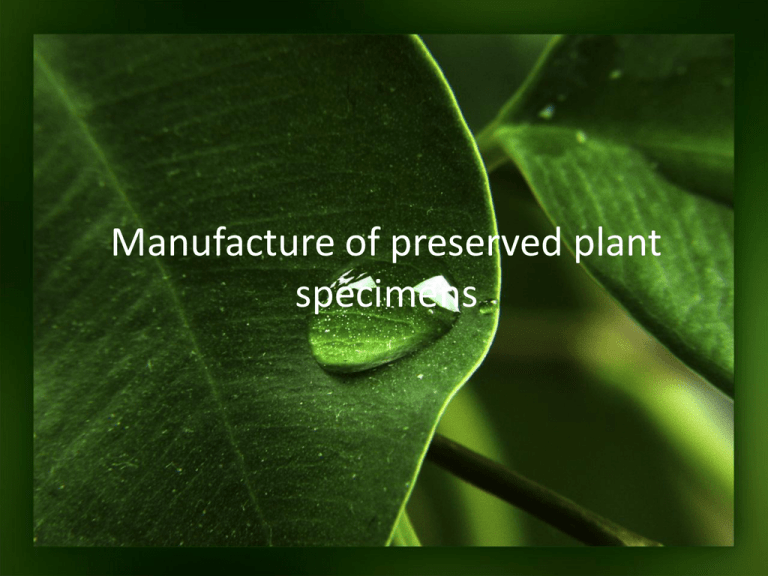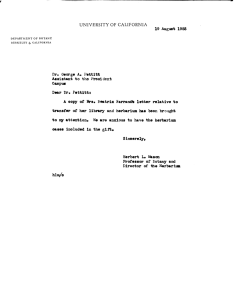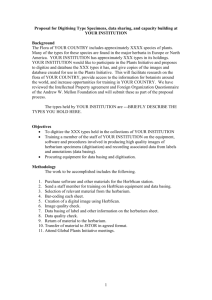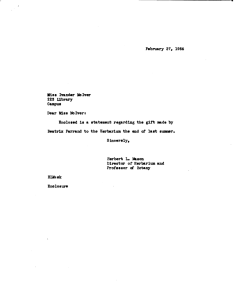Manufacture of preserved plant specimens
advertisement

Manufacture of preserved plant specimens Type of preserved plant specimens 1. Dry curing Dry curing, the plants preserved in the herbarium. 2. Wet curing Wet mounted, both for animals and plants are usually made by soaking whole specimens in 4% formalin solution History Herbarium Herbarium is a term first used by Turnefor (1700) for the dried herbs as a collection. Luca Ghini (1490-1550) Professor of Botany at the University of Bologna, Italy was the first to dry the plants under pressure and attach it on paper and make notes as scientific collections (Arber, 1938). At first many herbarium specimens are stored in the book as a private collection but in the 17th century this practice has grown and spread in Europe. Karl von Linné (1707-1778) was the man credited with developing the herbarium techniques (de Wolf, 1968 and Radford et al., 1974 in Bridson and Forman, 1998). Definition of Herbarium Herbarium derived from the word "Hortus and Botanicus", meaning the dried botanical garden. Simply put in question the herbarium is a collection of specimens that have been dried, usually prepared on the classification system. Function of Herbarium As a reference center, a main source for identification of plants for experts taxonomy, ecology, workers who handle rare plant species, nature lovers, the officers engaged in nature conservation. As an institution that has the documentation is a collection of historical value, such as the type of new taxa, new discoveries example, plants that have economic value, and others. As a central repository of data chemists use to study the alkaloid, pharmacists use to find the ingredients for cancer drugs, and so forth. Tools and materials a. b. c. d. e. f. g. h. Herbarium 1) carton / duplek 2) newsprint 3) sasak from bamboo / triplex 4) plant samples 5) stationery Wet curing bottles at sample specimens Formalin Distilled water measuring cup paper label Taking Plants The terms in making plant is a plant should be complete. Complete here is composed of leaves, flowers, and fruit. Please note that the interest is more important than the fruit, because of the interest we can identify better supported by data such as number of crowns, the pistil / benangsari, etc.. In making there are also so-called anticipation. Anticipation do when we want to identify plants that have no flowers or fruit. So what we do is take the plant stem (rod-shaped tilted ingat! cuts to avoid the accumulation of rain water and dew). of the leaf, we can determine clump or tribe of plants. After the material is taken, we hang tag (paper lace) to provide data on the plant which consists of: name (insial), decision date, and number. We fill in the data sequence number, if done in the day, date and month of the same. If we do capture the next day, then no. start from scratch again sorted. • • • The kind that would be Preserved Smaller plants should be collected the entire organ Large plant or tree, collected some branches with a length of 30-40 cm that has a complete organs: leaves (at least to have 3 leaf to see phylotaksis), flowers and fruit, taken from one plant. For a very tall tree, making the generative organs could be done with the pole vault, catapult or using animals, such as monkey. For tree or shrub is sometimes necessary to collect the bud (new leaves) because sometimes easy to fall and brakhtea stipulanya often found only on the young parts. Herbaceous plants were collected all his organs except for herbs such as Araceae. Collection of plant life, it is recommended to be planted in botanical gardens and greenhouses. Example: - Epiphyte, orchid roots wrapped in moss, the roots of the nails, coconut fiber -The seeds of water plants kept in water - The seeds do not dry capsule taken from the capsule. Activity a. Creating Herbarium take one plant / part of plant 1. enter it in sasak bamboo plants that have been made and pat dry with a drying plant to sun exposure. 2: adjust the crop position on the sheet of paper until rata.lapisi again with a few sheets of newspaper, handfuls with plywood on both sides and tie securely so that the plant was press firmly. newspaper with a dry dressing every time the newspaper wrapping wet plants. done repeatedly until the crop is completely dry. Some of the leaf facing upwards and a few others down. plant is said to dry if it has been quite stiff and does not feel cold. herbarium of plants that will be created, should have a complete parts. if its easy interest rates fall then enter it in an envelope and tuck in the herbarium. leaves or plant parts that are too long can be folded. plants that have dried glue on the cardboard using a stitch rope / tape. usahan appearance of the upper and lower leaf appearance are shown. complete information contained in the book collector Activity • Make Wet curing 1) prepare specimens to be preserved 2) provide that has diluted formalin liking. 3) enter the specimens in formalin solution that already exist in the bottle an hour and has been diluted. 4) close the bottle tightly and then given a label containing the name of the specimen and relatives. Labeling Conditions Preserved that have been made later included in the list of inventory collection. Recording made into a field book / collector book, while at the herbarium of plants included in the description of etiquette. In the herbarium there are two kinds of etiquette, the etiquette suspension containing about; number of collections, collector's initials, date of specimen collection and regency levels taking place (for the front) and the scientific name of the specimen (to the rear). On the outboard etiquette that should be included among others; letterhead (letterhead) as an identity identifier collector / institution shade, (No), number of collections, (ss) date of capture, family, genus, species, local name, (dd) the date attached, (determination) the name of the person who identified the specimen, (insula), the island took place, (m) in altitude retrieval of sea surface, (loc) district place-making, and (annotatione) description of the specimen. No Criteria 1 No 2 Date 3 Famili 4 Genus 5 Species 6 Name of the area 7 8 Date of determination Information of the place (elevation of the location of the collected object Herbarium Storage Technique 1. Storage piles herbarium should be camphor (camphor). 2. stored in specially designed cabinets that antiinsect. 3. The temperature should be 20 degrees Celsius, with no possibility that the temperature outside was not anything. 4. For specimens in the freezer, usually use a temperature of 20 degrees Celsius.





